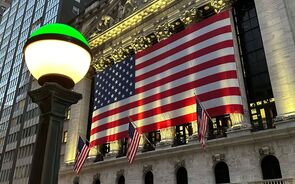Charles Biderman
1 Mensagem
|Página 1 de 1
Charles Biderman
At TrimTabs, we view the stock market essentially as a casino. Public companies are the house, while investors are the players. The basic premise of our approach is that stock prices in the casino are determined mainly by liquidity -- the supply of shares and the money available to buy them -- rather than fundamental value.
There are two major reasons why we think that the current stock market is a bubble. First, the house has not been buying much lately, either through stock buybacks or purchases of public companies for cash. Second, the players have been buying heavily, which usually occurs at or near market tops.
When the players are buying and the house is not, the market will begin to decline once the house begins printing more shares than the players' cash can absorb.
On the surface, corporate buying looks active enough. In the four weeks since Christmas, the weekly dollar amount of newly announced cash takeovers has averaged $450 million, and the weekly dollar amount of newly announced stock buybacks has averaged $3.9 billion.
Yet corporate buying has been highly concentrated in a few large-capitalization names, which makes it appear stronger than it actually has been. Since Christmas, a mere seven cash takeovers and 18 buybacks have been announced.
Recent buyback figures would be far more bullish if buyback activity were more broadly based. For example, in December 2003, the dollar amount of buybacks totaled an impressive $26 billion, but only 43 buybacks were announced. By contrast, in October 2002 -- the recent bottom in the stock market -- the dollar amount of buybacks was $15.4 billion, but the number of buybacks reached 130.
Given current stock valuations, the lack of broad-based corporate buying is not surprising, and we doubt that it will strengthen any time soon.
Instead of buying, both public companies and the insiders who run them have been selling new shares to eager investors. During the first three weeks of January, new offerings have averaged a healthy $4.1 billion weekly -- and January historically has been a slow month for new offerings. At the same time, corporate insiders have been selling heavily. While insider selling generally slows during the holidays, insider selling reached a $3.4 billion average weekly pace in November and a $2.4 weekly pace in December.
In January, insider selling declined to $2 billion weekly, which is not surprising because January is an earnings reporting month, and blackout periods prohibit many insiders from selling. Insider selling should surge in the weeks ahead if it follows its historical pattern.
Flooding the market with fresh cash
There is a second major reason why we believe that a bubble exists: the players have been clamoring to buy stock, which they usually do at or near market tops. Over the past few weeks, inflows of cash into the stock market have been extremely heavy.
Online brokers are reporting strong inflows directly into equities, and we estimate that $13.6 billion poured into all U.S. equity funds during the first 13 days of January. This inflow is the largest inflow during the first 13 days of the month since this bull market began in April 2003. It is entirely possible that inflows into U.S. equity funds in January could top the all-time record January inflow of $28 billion in January 2000. We all know what happened shortly after that.
What are the sources for all of this cash?
First, individuals are eagerly chasing the stock market gains of the past nine months with year-end bonus money and retirement plan contributions.
Second, many companies have been pouring money into their pension funds over the past two months to close massive gaps between plan assets and future liabilities. Much of this new money is finding its way into the stock market.
Investor optimism about equities has reached extraordinary levels, which is another contrary indicator. On Jan. 23, the CBOE Volatility Index (VIX: news, chart, profile) closed at 14.74, its lowest close since November 1996. In its most recent survey, the American Association of Individual Investors (AAII) reports that a record high 69.5 percent of investors are bullish, 17.1 percent are neutral, and a mere 13.4 percent are bearish. The eight-week moving average of bullish AAII investor sentiment has climbed to 64 percent, which is higher than at any time during the 1999-2000 bubble.
Bubble will burst when corporate selling overwhelms inflows
If the stock market is a bubble, why have we been mostly fully bullish since the end of October 2003? The answer is simple. Massive inflows from individuals and pension funds, combined with limited corporate buying, have far outweighed corporate selling.
The stock market will face headwinds as it enters a less seasonally strong period. The new offering calendar has been growing recently, and the pace of insider selling is likely to accelerate in February because blackout periods that have prevented insiders from selling have been lifted.
In sum, the new offering calendar and insider selling could easily drain $50 billion from the checking accounts of stock market intermediaries in February -- but that $50 billion is only a guess. In addition, inflows should weaken somewhat in the coming weeks. Many individuals have spent their year-end bonus and retirement fund ammunition, and pension fund inflows should slow by the end of February.
We are awaiting confirmation that the supply of new shares via offerings and insider selling reaches at least $10 billion weekly before we turn bearish. Right now, the stock market casino is doing an outstanding job of separating the players from their money. At some point soon, the house will flood the market with a torrent of new shares that will soak up all of this cash. Then it will be time to sell. Of course, exactly when the top will occur will only be known in hindsight. It could be as soon as February, but it could also be several months from now. It all depends upon how maniacal individual investors want to be in throwing good money after bad.
abraço.
There are two major reasons why we think that the current stock market is a bubble. First, the house has not been buying much lately, either through stock buybacks or purchases of public companies for cash. Second, the players have been buying heavily, which usually occurs at or near market tops.
When the players are buying and the house is not, the market will begin to decline once the house begins printing more shares than the players' cash can absorb.
On the surface, corporate buying looks active enough. In the four weeks since Christmas, the weekly dollar amount of newly announced cash takeovers has averaged $450 million, and the weekly dollar amount of newly announced stock buybacks has averaged $3.9 billion.
Yet corporate buying has been highly concentrated in a few large-capitalization names, which makes it appear stronger than it actually has been. Since Christmas, a mere seven cash takeovers and 18 buybacks have been announced.
Recent buyback figures would be far more bullish if buyback activity were more broadly based. For example, in December 2003, the dollar amount of buybacks totaled an impressive $26 billion, but only 43 buybacks were announced. By contrast, in October 2002 -- the recent bottom in the stock market -- the dollar amount of buybacks was $15.4 billion, but the number of buybacks reached 130.
Given current stock valuations, the lack of broad-based corporate buying is not surprising, and we doubt that it will strengthen any time soon.
Instead of buying, both public companies and the insiders who run them have been selling new shares to eager investors. During the first three weeks of January, new offerings have averaged a healthy $4.1 billion weekly -- and January historically has been a slow month for new offerings. At the same time, corporate insiders have been selling heavily. While insider selling generally slows during the holidays, insider selling reached a $3.4 billion average weekly pace in November and a $2.4 weekly pace in December.
In January, insider selling declined to $2 billion weekly, which is not surprising because January is an earnings reporting month, and blackout periods prohibit many insiders from selling. Insider selling should surge in the weeks ahead if it follows its historical pattern.
Flooding the market with fresh cash
There is a second major reason why we believe that a bubble exists: the players have been clamoring to buy stock, which they usually do at or near market tops. Over the past few weeks, inflows of cash into the stock market have been extremely heavy.
Online brokers are reporting strong inflows directly into equities, and we estimate that $13.6 billion poured into all U.S. equity funds during the first 13 days of January. This inflow is the largest inflow during the first 13 days of the month since this bull market began in April 2003. It is entirely possible that inflows into U.S. equity funds in January could top the all-time record January inflow of $28 billion in January 2000. We all know what happened shortly after that.
What are the sources for all of this cash?
First, individuals are eagerly chasing the stock market gains of the past nine months with year-end bonus money and retirement plan contributions.
Second, many companies have been pouring money into their pension funds over the past two months to close massive gaps between plan assets and future liabilities. Much of this new money is finding its way into the stock market.
Investor optimism about equities has reached extraordinary levels, which is another contrary indicator. On Jan. 23, the CBOE Volatility Index (VIX: news, chart, profile) closed at 14.74, its lowest close since November 1996. In its most recent survey, the American Association of Individual Investors (AAII) reports that a record high 69.5 percent of investors are bullish, 17.1 percent are neutral, and a mere 13.4 percent are bearish. The eight-week moving average of bullish AAII investor sentiment has climbed to 64 percent, which is higher than at any time during the 1999-2000 bubble.
Bubble will burst when corporate selling overwhelms inflows
If the stock market is a bubble, why have we been mostly fully bullish since the end of October 2003? The answer is simple. Massive inflows from individuals and pension funds, combined with limited corporate buying, have far outweighed corporate selling.
The stock market will face headwinds as it enters a less seasonally strong period. The new offering calendar has been growing recently, and the pace of insider selling is likely to accelerate in February because blackout periods that have prevented insiders from selling have been lifted.
In sum, the new offering calendar and insider selling could easily drain $50 billion from the checking accounts of stock market intermediaries in February -- but that $50 billion is only a guess. In addition, inflows should weaken somewhat in the coming weeks. Many individuals have spent their year-end bonus and retirement fund ammunition, and pension fund inflows should slow by the end of February.
We are awaiting confirmation that the supply of new shares via offerings and insider selling reaches at least $10 billion weekly before we turn bearish. Right now, the stock market casino is doing an outstanding job of separating the players from their money. At some point soon, the house will flood the market with a torrent of new shares that will soak up all of this cash. Then it will be time to sell. Of course, exactly when the top will occur will only be known in hindsight. It could be as soon as February, but it could also be several months from now. It all depends upon how maniacal individual investors want to be in throwing good money after bad.
abraço.
- Mensagens: 544
- Registado: 6/12/2002 0:05
1 Mensagem
|Página 1 de 1
Quem está ligado:
Utilizadores a ver este Fórum: aaugustob69, Bing [Bot], Google [Bot], Kiko_463, m-m, PAULOJOAO, Purificaçao e 122 visitantes


